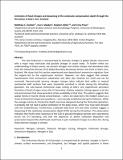Files in this item
Limitation of fixed nitrogen and deepening of the carbonate-compensation depth through the Hirnantian at Dob's Linn, Scotland
Item metadata
| dc.contributor.author | Koehler, Matthew C. | |
| dc.contributor.author | Stüeken, Eva E. | |
| dc.contributor.author | Hillier, Stephen | |
| dc.contributor.author | Prave, Tony | |
| dc.date.accessioned | 2020-08-11T23:36:21Z | |
| dc.date.available | 2020-08-11T23:36:21Z | |
| dc.date.issued | 2019-11-15 | |
| dc.identifier | 260662750 | |
| dc.identifier | 092d8b71-c837-424c-bc5d-9c145c36c965 | |
| dc.identifier | 85070873135 | |
| dc.identifier | 000504504200018 | |
| dc.identifier.citation | Koehler , M C , Stüeken , E E , Hillier , S & Prave , T 2019 , ' Limitation of fixed nitrogen and deepening of the carbonate-compensation depth through the Hirnantian at Dob's Linn, Scotland ' , Palaeogeography, Palaeoclimatology, Palaeoecology , vol. 534 , 109321 . https://doi.org/10.1016/j.palaeo.2019.109321 | en |
| dc.identifier.issn | 0031-0182 | |
| dc.identifier.other | RIS: urn:DE6EB4D568BCE78B0E8E78B90F334AD5 | |
| dc.identifier.other | ORCID: /0000-0002-4614-3774/work/64033701 | |
| dc.identifier.other | ORCID: /0000-0001-6861-2490/work/65014414 | |
| dc.identifier.uri | https://hdl.handle.net/10023/20447 | |
| dc.description | This study was funded by University of Washington Department of Earth and Space Sciences Harry Wheeler Scholarship and Jody Bourgeois Graduate Student Support Fund granted to MCK. Stephen Hillier acknowledges support of the Scottish Government's Rural and Environment Science and Analytical Services Division (RESAS). | en |
| dc.description.abstract | The late Ordovician is characterized by dramatic changes in global climate concurrent with a major mass extinction and possible changes in ocean redox. To further refine our understanding of these events, we present nitrogen and carbon isotope and abundance data from the Ordovician-Silurian (O-S) Global Boundary Stratotype Section and Point at Dob's Linn, Scotland. We show that this section experienced post-depositional ammonium migration from the organic-rich to the organic-poor horizons. However, our data suggest that isotopic fractionations from ammonium substitution into illitic clay minerals are small and can be corrected. Reconstructed primary nitrogen isotope ratios indicate that unlike in tropical continental shelf sections that were transiently enriched in nitrate during the Hirnantian glaciation, the sub-tropical continental slope setting at Dob's Linn experienced persistent limitation of fixed nitrogen across the O-S boundary. Shallow subpolar settings appear to be the only environment that shows persistent nitrate availability at that time. This pattern suggests that spatial trends in marine nitrate concentrations – which are observed in the modern ocean as a result of latitudinal temperature gradients – were already established during the Paleozoic. While the average marine O2 chemocline depth may have deepened during the Hirnantian glaciation, it probably did not lead to global ventilation of the deep ocean, which may have been delayed until the Carboniferous. Furthermore, carbonate data from this and other sections suggest a deepening of the carbonate compensation depth (CCD) during the Hirnantian. This observation indicates that Pacific-style responses of the CCD to glacial/interglacial periods were operational across the O-S boundary, and that the expansion of abiotic carbonate deposition and preservation beyond the shelf break could have in-part mediated changes to surface CO2 during these extreme changes in climate. | |
| dc.format.extent | 1497577 | |
| dc.language.iso | eng | |
| dc.relation.ispartof | Palaeogeography, Palaeoclimatology, Palaeoecology | en |
| dc.subject | Nitrogen isotopes | en |
| dc.subject | Paleozoic nitrogen cycling | en |
| dc.subject | Abiogenic carbonate storage | en |
| dc.subject | Ammonium migration | en |
| dc.subject | Nitrogen in clay | en |
| dc.subject | GE Environmental Sciences | en |
| dc.subject | DAS | en |
| dc.subject | SDG 13 - Climate Action | en |
| dc.subject | SDG 14 - Life Below Water | en |
| dc.subject.lcc | GE | en |
| dc.title | Limitation of fixed nitrogen and deepening of the carbonate-compensation depth through the Hirnantian at Dob's Linn, Scotland | en |
| dc.type | Journal article | en |
| dc.contributor.institution | University of St Andrews. School of Earth & Environmental Sciences | en |
| dc.contributor.institution | University of St Andrews. St Andrews Centre for Exoplanet Science | en |
| dc.contributor.institution | University of St Andrews. Scottish Oceans Institute | en |
| dc.contributor.institution | University of St Andrews. St Andrews Sustainability Institute | en |
| dc.contributor.institution | University of St Andrews. St Andrews Isotope Geochemistry | en |
| dc.contributor.institution | University of St Andrews. Marine Alliance for Science & Technology Scotland | en |
| dc.identifier.doi | https://doi.org/10.1016/j.palaeo.2019.109321 | |
| dc.description.status | Peer reviewed | en |
| dc.date.embargoedUntil | 2020-08-12 |
This item appears in the following Collection(s)
Items in the St Andrews Research Repository are protected by copyright, with all rights reserved, unless otherwise indicated.

